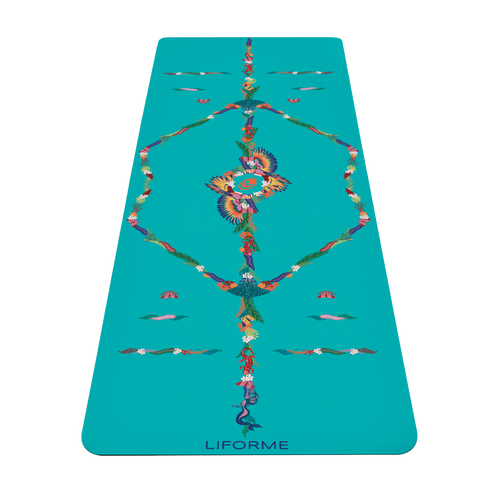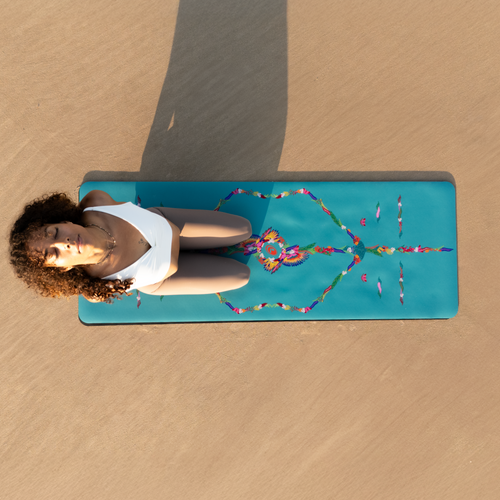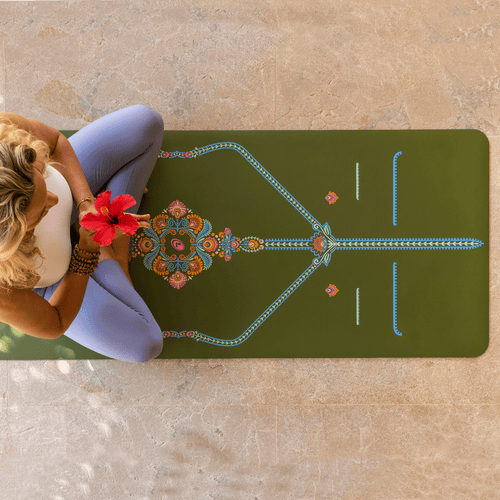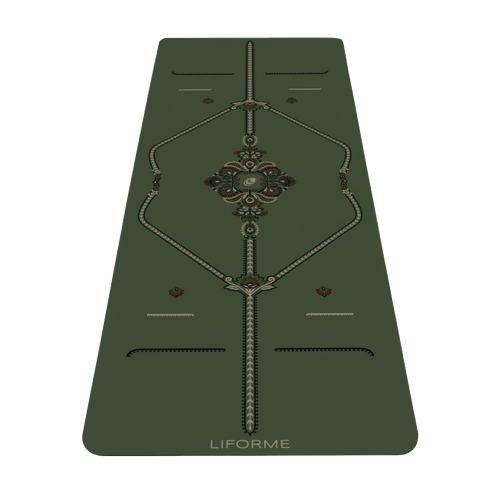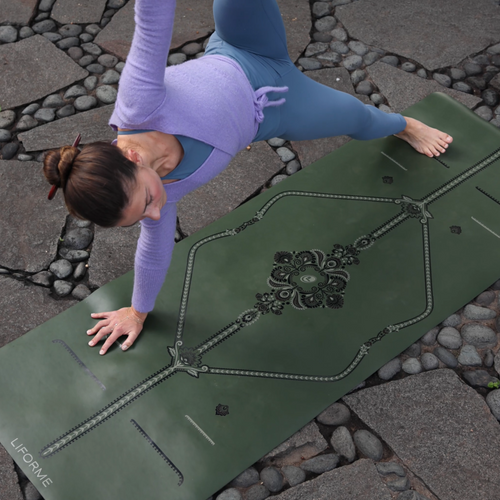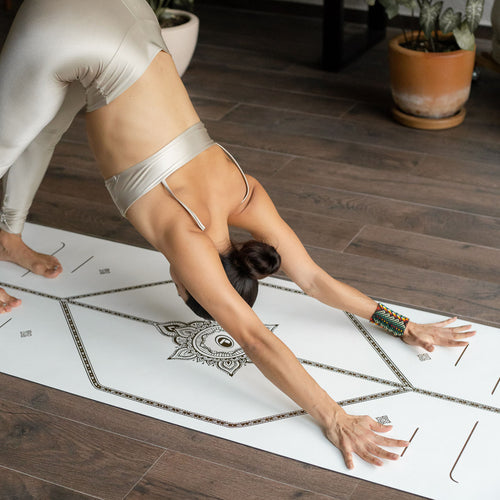Are you here because you just Googled ‘Yoga for Back Pain’? If so, you’re not alone! Relief from back pain is a huge reason why many people get into yoga.
The good news is that the spinal mobility, back and core strength, and overall flexibility you get from a consistent, well-rounded yoga practice are all very effective in combating back pain.
The not-so-good news? Every person’s back pain has unique causes, so no single sequence works for everyone. If you’re currently experiencing pain from an injury, consult a healthcare provider before trying new movements. You may need to start your recovery journey by working with a physical therapist on a program that is designed for your specific condition.
Once you’ve determined which movements are safe for your body, yoga can become a powerful long-term tool for both relief and prevention. Below you’ll find the 13 best yoga poses for back pain prevention. These postures build strength and flexibility in the spine, hips, and core, creating a strong foundation for a pain-free back.
Beginner-Friendly Yoga Poses for Back Pain Prevention

Cat-Cow Stretch (Marjaryasana-Bitilasana)
Sanskrit Meaning: Marjary (Cat) Asana (Pose) and Bitil (Cow) Asana (Pose)
Yoga Level: Beginner
Pose Type: Kneeling
Why this Pose: Brings your attention to your entire spine as you initiate movement from crown to tail. Also warms up your back and strengthens your core.
Step-by-Step Instructions:
1. Begin on your hands and knees with your shoulders over your wrists and your hips over your knees.
2. On an inhalation, lift your head, drop your belly, and lift your tail. Keep your naval drawn in toward your spine. This is Cow Pose, a position of spinal extension.
3. On an exhalation, drop your head, round your back, and tuck your tail. This is Cat Pose, a position of spinal flexion.
4. Continue for 5-10 breaths.
 Child’s Pose (Balasana)
Child’s Pose (Balasana)
Sanskrit Meaning: Bala (Child) Asana (Pose)
Yoga Level: Beginner
Pose Type: Kneeling
Why this Pose: Stretches your spine, shoulders, hip flexors, and thighs.
Step-by-Step Instructions:
1. Begin in a hands-and-knees position.
2. Bring your knees wide toward the edges of your mat and your big toes to touch.
3. Lower your butt towards your heels while keeping your arms outstretched.
4. Rest your forehead on the mat.
 Puppy Pose (Uttana Shishosana)
Puppy Pose (Uttana Shishosana)
Sanskrit Meaning: Uttana (Intense) Shisho (Puppy) Asana (Pose)
Yoga Level: Beginner
Pose Type: Kneeling
Why this Pose: Nice stretch for your back and shoulders.
Step-by-Step Instructions:
1. Begin on your hands and knees.
2. Keep your hips stacked over your knees as you walk your hands forward.
3. Lower your chest or chin to the mat.
 Sphinx Pose (Salamba Bhujangasana)
Sphinx Pose (Salamba Bhujangasana)
Sanskrit Meaning: Salamba (Supported) Bhujanga (Cobra) Asana (Pose)
Yoga Level: Beginner
Pose Type: Prone
Why this Pose: Gentle backbend that strengthens your spine and opens your chest.
Step-by-Step Instructions:
1. Come to lie on your stomach with your chest propped up by your arms.
2. Make sure your elbows are under your shoulders and your forearms are parallel.
3. Press into your forearms to increase the space between your shoulder and your ears.
4. Hold for several breaths.
 Low Cobra Pose (Bhujangasana)
Low Cobra Pose (Bhujangasana)
Sanskrit Meaning: Bhujanga (Cobra) Asana (Pose)
Yoga Level: Beginner
Pose Type: Prone
Why this Pose: Using your back muscles to lift your chest is one of the best ways to strengthen them.
Step-by-Step Instructions:
1. Lie on your stomach with your palms flat on the mat directly under your shoulders and your elbows pointing straight back.
2. On an inhalation, press through the tops of your feet and anchor your pelvis to the floor to lift your chest away from the mat without pressing into your hands at all.
3. Release on an exhalation and repeat three times.

Locust Pose (Salabhasana)
Sanskrit Meaning: Salabha (Locust) Asana (Pose)
Yoga Level: Intermediate
Pose Type: Prone
Why this Pose: Strengthens your back, abs, legs, and glutes.
Step-by-Step Instructions:
1. Lie on your stomach with your arms alongside your body.
2. Press the tops of your feet and pelvis into your mat to lift your chest and arms away from the floor on an inhalation of breath. You may want a Yoga Pad under your hip points for more cushioning.
3. You can experiment with lifting your feet off the floor for more intensity.

Standing Forward Fold (Uttanasana)
Sanskrit Meaning: Uttana (Intense) Asana (Pose)
Yoga Level: Beginner
Pose Type: Standing
Why this Pose: Stretches the backs of your legs and decompresses your spine.
Precautions: Avoid this pose if you have herniated discs
Step-by-Step Instructions:
1. Stand in Mountain Pose (Tadasana) at the front of your mat.
2. On an inhalation, lift your arms overhead, stretching toward the ceiling.
3. On your next exhalation, take your arms out wide as you hinge from the pelvis to forward fold over your legs.
4. Soften your knees if your hamstrings are tight.
5. Release your neck and let your head hang heavy.

Downward Facing Dog (Adho Mukha Svanasana)
Sanskrit Meaning: Adho (Down) Mukha (Face) Svana (Dog) Asana (Pose)
Yoga Level: Beginner
Pose Type: Standing
Why this Pose: Strengthens and stretches the entire back.
Step-by-Step Instructions:
1. Begin on your hands and knees with your toes curled under.
2. On an exhalation, press into your hands to lift your butt toward the ceiling.
3. Keeping your hips high, straighten your legs and release your heels toward the floor.
4. Roll your upper arms outward.
5. Let your head hang heavy.
6. Take five to ten breaths.
 Triangle Pose (Trikonasana)
Triangle Pose (Trikonasana)
Sanskrit Meaning: Trikona (Triangle) Asana (Pose)
Yoga Level: Beginner
Pose Type: Standing
Why this Pose: Strengthens your back and core, elongates your spine, and improves balance.
Step-by-Step Instructions:
1. Take a wide-legged stance facing the long side of your mat.
2. If your mat has alignment guidance, place your feet so your front heel intersects the back arch along the Central Line. If it doesn’t, imagine a straight line running from your front heel to the middle of your back foot.
3. Lift your arms parallel to the floor.
4. Reach your right arm forward, lengthening through your side body, then lower your right hand to your shin, the floor, or a block.
5. Turn your chest and your gaze toward the ceiling.
6. After several breaths, return to centre and repeat the pose on your left side.

Bridge Pose (Setu Bandhasana)
Sanskrit Meaning: Setu (Bridge) Bandha (Lock) Asana (Pose)
Yoga Level: Beginner
Pose Type: Supine Backbend
Why this Pose: Strengthens your glutes, abs, back, and thighs. Gently extends your spine.
Step-by-Step Instructions:
1. Lie on your back with your feet flat on the floor and knees bent toward the ceiling.
2. Position your feet so you can touch your heels with your fingertips. Keep your feet parallel.
3. On an inhalation, press into your feet and use your glutes to lift your pelvis off the floor.
4. To open your chest more, interlace your hands behind your back and roll your shoulders under one at a time.
5. Keep your head in a neutral position.
6. After several breaths, release. Repeat the posture three times.

Supine Spinal Twist (Supta Matsyendrasana)
Sanskrit Meaning: Supta (Reclined) Lord of Fishes (Matsyendra) Asana (Pose)
Yoga Level: Beginner
Pose Type: Supine
Why this Pose: Relieves stiffness and improves spinal mobility.
Step-by-Step Instructions:
1. Lie on your back with your legs outstretched.
2. Hug your right knee into your chest.
3. Guide your right knee across your body to the left side of your mat.
4. Lift your hips and scoot them to the right a little bit.
5. Reach your right arm out to the right and take your gaze to your right hand.
 Eye of the Needle Pose (Sucirandhrasana)
Eye of the Needle Pose (Sucirandhrasana)
Sanskrit Meaning: Suci (Needle) Randhra (Hole) Asana (Pose)
Also Known As: Reclined Pigeon
Yoga Level: Beginner
Pose Type: Supine
Why this Pose: Stretches your hip flexors and lower back, alleviating tightness.
Step-by-Step Instructions:
1. Lie on your back with your knees bent toward the ceiling.
2. Hug your right knee into your chest.
3. Use your hands to place your right ankle on top of your left thigh, close to your left knee.
4. Open your right knee to the right.
5. Stay here or lift your left foot off the floor and hold onto the back of your left thigh.
6. After several breaths, release and repeat on the other side.

Legs Up the Wall Pose (Viparita Karani)
Sanskrit Meaning: Viparita (Inversion) Karani (to do)
Yoga Level: Beginner
Pose Type: Supine
Precautions: Avoid inversions if you have glaucoma
Why this Pose: A gentle stretch for the lower back and the backs of your legs.
Step-by-Step Instructions:
1. Bring your mat over to a wall.
2. Sit with your knees drawn into your chest and one side of your body against the wall.
3. Roll onto your back and simultaneously take your legs up the wall.
4. Relax here for as long as you like.
Benefits of Yoga for Back Pain
Back pain is a huge problem for many people, especially as they grow older. A sedentary lifestyle can be a cause, as are weak core and back muscles. These contribute to a lack of mobility and spinal compression. The prescription for preventing back pain is movement that builds strength and flexibility. Yoga fits the bill.
Builds Core and Back Strength
Many yoga poses target the deep core muscles, glutes, and spinal extensors. Strengthening these areas provides vital support for the lower back and helps maintain proper posture, reducing strain on the spine.
Improves Flexibility and Mobility
Tight hamstrings, hips, and shoulders often contribute to back discomfort. Yoga stretches these areas, releasing stiffness and restoring a healthy range of motion. Greater flexibility helps ease existing pain and lowers the risk of future injury.
Relieves Stress and Tension
Stress often shows up physically as muscle tightness, especially in the shoulders, neck, and back. Breathing exercises and gentle yoga poses encourage relaxation, allowing muscles to soften and release.
Encourages Long-Term Consistency
Unlike quick fixes, yoga offers sustainable results when practiced regularly. Even short, consistent sessions promote gradual improvements in strength, flexibility, and awareness, all of which help keep back pain at bay.
Precautions for Practicing Yoga with Back Pain
While yoga can be highly beneficial for back pain, it’s important to practice safely. Because every body, and every back issue, is different, what helps one person may not be suitable for another. Always listen to your body and adapt as needed.
- Consult a healthcare professional: If your back pain is severe, caused by injury, or linked to conditions like herniated discs or sciatica, get medical clearance before starting yoga. A doctor or physical therapist can advise which movements to avoid.
- Move slowly and mindfully: Rushing into deep stretches or forcing your body can aggravate pain. Focus on slow, controlled movements and use your breath to guide transitions.
- Modify with props: Blocks, bolsters, or rolled-up blankets can support the spine and make poses more accessible. Props help reduce strain and allow you to experience the benefits without overexertion.
- Avoid overstretching: It can be tempting to push for a deeper stretch, but overstretching may worsen existing back issues. Aim for gentle lengthening instead of intensity.
- Skip certain poses if needed: Not every yoga position for back pain is right for everyone. Deep backbends, aggressive twists, or forward folds with locked knees may aggravate discomfort if practiced incorrectly.
Yoga Poses to Avoid with Back Pain
Certain movements can aggravate back issues, especially if done without proper guidance. If you’re dealing with pain, it’s best to approach these categories of poses with caution:
- Deep dackbends, such as full Wheel Pose or Camel Pose, which can compress the lower spine.
- Intense forward folds, especially with straight legs like the Seated Forward Fold. They may overstretch tight hamstrings and pull on the lower back.
- Strong twists, like Revolved Triangle, can strain spinal discs if forced.
- High-impact arm balances or inversions, like Handstand, are advanced poses that load the spine and require strong core engagement.
An Ounce of Prevention
The keys to fighting back pain with yoga are time and consistency. The poses above have wonderful benefits, but so do many, many other yoga postures. If you practice a variety of poses regularly, you’ll soon see improvement in your strength, flexibility, and mobility. This is the winning combination to keep back pain away.
Yoga for Back Pain FAQs
What type of yoga is best for back pain?
Gentle styles like Hatha and restorative yoga are often best for back pain, as they focus on slow movements, stretching, and breath awareness.
Is yoga good for lower back pain?
Yes. Poses that strengthen the core and stretch tight hips and hamstrings are especially effective for easing lower back pain. However, if your pain is acute or linked to an injury, consult a healthcare provider first and avoid forcing your body into deep stretches.
How often should I do yoga for back pain?
Consistency matters more than duration. Practicing even 15–20 minutes a few times a week can bring noticeable results.
Are there yoga positions for back pain I should avoid?
Yes. Deep backbends, aggressive twists, and forward folds without bent knees can aggravate pain if not practiced carefully. Ask your healthcare provider if there are other specific poses you should avoid.












